If you were expecting some kind of sun sign nonsense, forget about it. This is real astrology for the real world, not some mystical mumbo-jumbo word salad. If it's real astrology for yourself that you want, you can get it by phone or in print. And if you need help deciphering the astrological glyphs in the graphics accompanying this article, see Astroglyphs: Astrological Symbols Guide. Please note: this forecast is expressed in terms of Universal Time (UT). Also please be aware that, while I never change a forecast once it's published, I do post errata to acknowledge typographical errors and the like.
Study the past, if you would divine the future.
-- Confucius
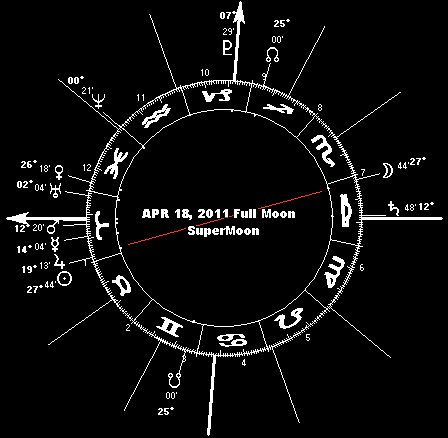 Theres still a lot of March in April, in so many ways. For one thing, theres another SuperMoon. I know this runs counter to all the uninformed media hype last month, the claims that the March 19 SuperMoon full moon was the first of its kind in nineteen years let alone the silly hysteria about apocalyptic catastrophes ushered in by a super-close full moon. I know better. I am after all the one who created and defined the term SuperMoon over thirty years ago now, in an article which appeared in the September, 1979 issue of Dell Publishing Companys HOROSCOPE magazine.
Theres still a lot of March in April, in so many ways. For one thing, theres another SuperMoon. I know this runs counter to all the uninformed media hype last month, the claims that the March 19 SuperMoon full moon was the first of its kind in nineteen years let alone the silly hysteria about apocalyptic catastrophes ushered in by a super-close full moon. I know better. I am after all the one who created and defined the term SuperMoon over thirty years ago now, in an article which appeared in the September, 1979 issue of Dell Publishing Companys HOROSCOPE magazine.
The fact of the matter, as I defined it then and there and have consistently indicated ever since, is that SuperMoons happen on average 4-6 times a year, whenever theres a close coincidence of perigee (the close approach point of the Moons monthly orbit around the Earth) and syzygy (a new or full moon). I long ago published tables of all 20th and 21st Century SuperMoons, to help people keep these things straight. Over-enthusiastic bloggers and others noticed that there was an unusually close SuperMoon on March 19, 2011 - and some of them practically went crazy with it.
All that hype created a lot of work for me, trying to set the record straight in a number of print and broadcast interviews in the weeks leading up to March 19 (as well as in an ongoing online article at my website). Of course, the media are always more interested in a good (preferably really scary) story than the truth. Rush Limbaugh fell prey to the media hype when he mentioned SuperMoon during his March 17 broadcast, saying that this guy Richard Nolle is out there warning everybody now that it could be disastrous out there which is unbelievably silly in view of what I actually wrote about the SuperMoons of 2011 last year:
Obviously it won't be the case that all hell will break loose all over the world within a few days either side of any given SuperMoon. For most of us, the geocosmic risk raised by SuperMoon alignments will pass with little notice in our immediate vicinity. In the grand scheme of things, we may live on a little blue marble in space; but its still a rather roomy planet, after all. A SuperMoon is planetary in scale, being a special alignment of Earth, Sun and Moon. By the same token, its planetary in scope, in the sense that there's no place on Earth not subject to the tidal force of the perigee-syzygy. Of course, earthquakes and volcanic eruptions don't go wandering all over the planet. They happen in (mostly) predictable locations, like the infamous "Ring of Fire" around the Pacific plate. If you're in (or plan to be in) a place that's subject to seismic upheaval during a SuperMoon stress window, it's not hard to figure out that being prepared to the extent that you can is not a bad idea. Likewise, people on the coast should be prepared for extreme tidal surges. Severe storms on the other hand can strike just about anywhere, so it behooves us all to be ready for rough weather when a SuperMoon alignment forms. Astro-locality mapping each SuperMoon can help indicate areas of special risk, but the whole planet is in the bulls eye when one of these geocosmic shock windows opens up. Dont be paranoid but dont be complacent, either.
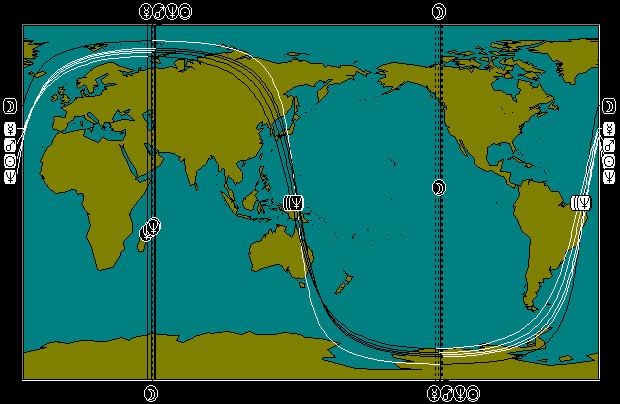 Clearly, what I actually wrote is the very antithesis of this "warning everybody now that it could be disastrous out there" silliness. My actual forecasts regarding the SuperMoons this year have been more focused. For example, with regard to the years first (February 18) SuperMoon, I wrote that "February 12-21 marks the temporal range of this particular SuperMoon, which appears to be most intense around the 13th (when the Moon hits maximum declination north of the celestial equator), the 18th and the 19th." And instead of a general and widespread apocalypse, my forecast specified what to expect:
Clearly, what I actually wrote is the very antithesis of this "warning everybody now that it could be disastrous out there" silliness. My actual forecasts regarding the SuperMoons this year have been more focused. For example, with regard to the years first (February 18) SuperMoon, I wrote that "February 12-21 marks the temporal range of this particular SuperMoon, which appears to be most intense around the 13th (when the Moon hits maximum declination north of the celestial equator), the 18th and the 19th." And instead of a general and widespread apocalypse, my forecast specified what to expect:
Stirring up strong tides in Earths crust, seas and atmosphere, this SuperMoon signals the usual: increased notable seismic activity (including magnitude 5+ earthquakes and volcanic activity), extreme tides (including tsunami resulting from the aforementioned seismic stuff), and severe storms (with high winds and heavy precipitation). A rash of weather-related crashes will likely make headlines, along with tie-ups in transportation and outages in power and communication infrastructure.
Anyone who followed the news knows what happened. The seismic activity started with a pair of magnitude 6.1 temblors on the 12th (one in Bio-Bio, Chile and one near the island of Tonga), another near Bio-Bio (a 6.0) on the 13th, a 6.6 offshore Maule, Chile on the 14th, a 6.1 in Sulawesi, Indonesia on the 15th, several 5+ in the South Pacific on the 16th, a 5.8 on Vanuatu on the 17th, five strong temblors on the 18th (including a 5.1 in Baja that shook San Diego), a couple more 5+ quakes on the 19th, another seven on the 20th (including a magnitude 6.2 along the Kamchatka coast), and seven more on the 21st including a magnitude 6.4 in Fiji, the last day of the SuperMoon shock window remember, my forecasts are all specified in Universal Time (UT). That was the same day that Christchurch was practically destroyed by a magnitude 6.3 earthquake, which has been called the deadliest natural disaster in New Zealand history. (The previous record-holder in that infamous category was the magnitude 7.9 quake that hit Hawkes Bay on February 3, 1931 on the very day of a SuperMoon.)
In the way of volcano action during the February 12-21 SuperMoon shock window, Bulusan in the Philippines began erupting on the 19th, forcing thousands of people to flee their homes. On the storm front, there was Cyclone Carlos hitting Darwin, Australia on the 16th, the strong winter storm hitting Idaho and Utah that same day, knocking out power to 21,000 homes; and the white-out conditions from the Dakotas through Minnesota and into Wisconsin on the 20th, dumping over a foot of snow in places and canceling hundreds of flights in the Twin Cities.
While there were lots of Chicken Littles running around foaming at the mouth over the March 19 SuperMoon, I had published a more considered forecast for the March 16-22 geocosmic shock window:
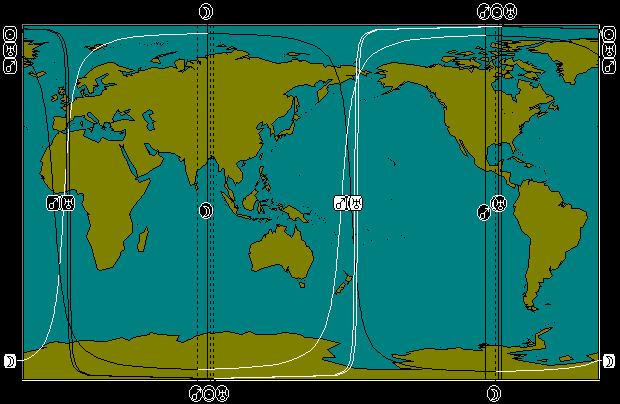 Of course you can expect the usual: a surge in extreme tides along the coasts, a rash of moderate-to-severe seismic activity (including Richter 5+ earthquakes, tsunami and volcanic eruptions), and most especially in this case a dramatic spike in powerful storms with heavy precipitation, damaging winds and extreme electrical activity. Floods are a big part of the picture in this case, although some of these will be dry electrical storms that spark fast-spreading wildfires.
Of course you can expect the usual: a surge in extreme tides along the coasts, a rash of moderate-to-severe seismic activity (including Richter 5+ earthquakes, tsunami and volcanic eruptions), and most especially in this case a dramatic spike in powerful storms with heavy precipitation, damaging winds and extreme electrical activity. Floods are a big part of the picture in this case, although some of these will be dry electrical storms that spark fast-spreading wildfires.
Being planetary in scale, theres no place on our home planet thats beyond the range of a SuperMoon, so it wouldnt hurt to make ready wherever you are or plan to be during the March 16-22 SuperMoon risk window. That said, possible zones of special vulnerability may be indicated by astro-locality mapping this particular SuperMoon alignment. Among these are longitudinal meridian lines defining a swath of elevated risk running through North and Central America from Chicago at the eastern edge to Winnipeg and Mexico City on the west. This same longitudinal swath crosses the poles to sketch out a similar swath in Asia, through Siberia, eastern India, Bangladesh, Nepal, western China and Mongolia. In addition, horizon arcs sweep from New Zealand through the Pacific across to the Russian side of the Bering Strait, across Greenland and Iceland, and down through northern and western Europe and west Africa.
Again, the headlines documented what was promised for this SuperMoon, including a magnitude 6.3 quake in Vanuatu (right under one of those horizon arcs I mentioned as a zone of special vulnerability), the Karangetang volcano eruption in Indonesia, and powerful storms from the US Pacific coast on into the Midwest.
The biggest geophysical headline of March wasnt associated with that months SuperMoon, but instead with a lunar north declination peak on the 12th, sandwiched between two SuperMoons. It coincided with the magnitude 9.0 earthquake off the coast of Japan, and a subsequent tsunami. Sound familiar? Remember the infamous Aceh quake and tsunami of December 26, 2004? Same deal: a lunar north declination peak on December 26, midway between the SuperMoons of December 12, 2004 and January 10, 2005.
Comes April, and here we go again. Another SuperMoon (on the 18th), and another lunar north declination peak (on the 8th) sandwiched between the March 19 and April 18 SuperMoons. What to expect? Ive already described it in my 2011 World Forecast Highlights:
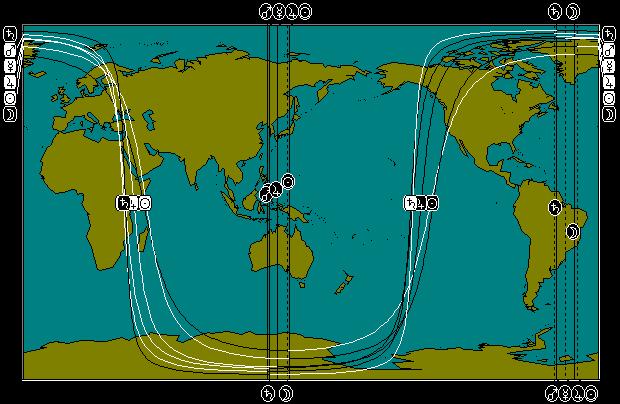 The April 18 full moon at 27° 44 Libra is the years third SuperMoon, and has an effective shock window that runs from the 14th through the 21st (and maybe a few hours into the 22nd). This is quite a complex in the sky, in which the full moon opposes the Sun, Mercury, Mars and Jupiter in Aries, with Mars also opposing Saturn and in a wide square to Pluto the latter factor turns the whole thing into a loose but effective and very extensive T-Square. This bespeaks lots of tension at all levels, from the geophysical to the geopolitical. The geopolitical element can indicate military or paramilitary threats and action the sort of thing that tends to panic markets for a time. The geophysical component is the usual SuperMoon stuff: damaging storms, moderate-to-severe seismic disturbances (magnitude 5+ earthquakes, volcanic eruptions), and extreme tidal surges (including tsunami). If you cant get out of the way entirely and you cant because this is a planetary phenomenon then you can at least have your emergency plans and preparations ready to hand. This includes lots of extra cash if you plan to be traveling as the SuperMoon lines up in the sky, with a Mercury Max cycle in effect at the same time: mass transit schedules tend to go out the window when they run head-on into a force majeure like this.
The April 18 full moon at 27° 44 Libra is the years third SuperMoon, and has an effective shock window that runs from the 14th through the 21st (and maybe a few hours into the 22nd). This is quite a complex in the sky, in which the full moon opposes the Sun, Mercury, Mars and Jupiter in Aries, with Mars also opposing Saturn and in a wide square to Pluto the latter factor turns the whole thing into a loose but effective and very extensive T-Square. This bespeaks lots of tension at all levels, from the geophysical to the geopolitical. The geopolitical element can indicate military or paramilitary threats and action the sort of thing that tends to panic markets for a time. The geophysical component is the usual SuperMoon stuff: damaging storms, moderate-to-severe seismic disturbances (magnitude 5+ earthquakes, volcanic eruptions), and extreme tidal surges (including tsunami). If you cant get out of the way entirely and you cant because this is a planetary phenomenon then you can at least have your emergency plans and preparations ready to hand. This includes lots of extra cash if you plan to be traveling as the SuperMoon lines up in the sky, with a Mercury Max cycle in effect at the same time: mass transit schedules tend to go out the window when they run head-on into a force majeure like this.
Again, let me emphasize that no one can afford complacency under a SuperMoon alignment, since the kind of heightened storm and seismic activity associated with this celestial phenomenon can reach anywhere on Planet Earth. That said, east Asia from China down through Japan and the Korean Peninsula lies under a longitudinal astro-locality arc, which runs south through the Pacific to cross the Philippines, Indonesia and central Australia. On the other side of the world, this same arc runs through Greenland, easternmost Canada and eastern South America. Separately, a risky-looking horizon arc cuts across the California coast, the northwestern US, southern Alaska and western Canada, across Greenland and down through Scandinavia, eastern Europe, the Middle East and east Africa.
Before leaving the subject of geophysical turbulence, Im obliged to point out some generally lesser risk periods for moderate-to-severe seismic activity and powerful storms. These include April 1-9, associated with the Moons northward crossing of the celestial equator on the 1st, the new moon on the 3rd and the lunar north declination peak on the 8th. And at the end of the month comes the northward lunar equatorial crossing on the 28th, anchoring a brief geocosmic risk window from the 27th into the 30th in the lead-up to the May 3 new moon.
Jupiter-Saturn opposition. Exact on March 28, it lingers within a few degrees on into middle April.
Ive gone into the context of this in great detail in past forecasts, which proved prophetic, if you read it word for word at the time. And if you didnt, nows a good time for a review.
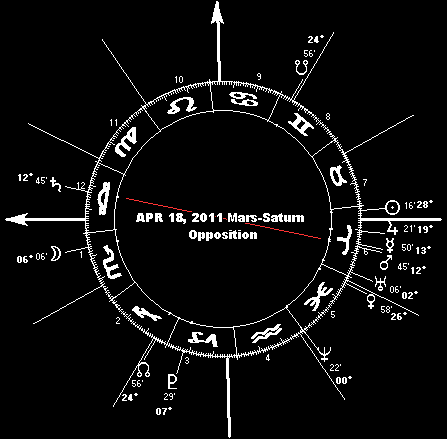 Meanwhile, dont lose sight of all the potential for "fires, clashes, crashes and explosions . . . a disruption in the oil and natural gas supply chain" on the horizon this month, continuing a theme in effect for most of the year so far. April and May brings a lot more Red Planet action: the alignment with Uranus on April 3 (protests turn into riots). The April 18 full moon SuperMoon Mars-Saturn opposition (just a week after the Mars Pluto waxing square) has some ominous antecedents, geopolitically as well as geophysically. A longitudinal swath touching Ottawa, New York, Washington, Cuba and Hispaniola and virtually all of western South America figures into this; as well as Indonesia, Indochina, China, Mongolia and Siberia and thats just the geopolitical end of the spectrum. (What kind of geopolitical risk? Look back to previous Mars-Saturn oppositions, just before and during the Korean War, in the Cuban Missile Crisis, etc.) Geophysically, these danger zones are shifted eastward, e.g. into central South America in the western hemisphere and eastern China, the Korean Peninsula, the Philippines, Indonesia and Australia in the east. And then theres the conjunction with Jupiter on May 1: this Red Planet stuff keeps shifting but never really goes away and neither do the uprisings that began under the Sun-Mars conjunction back in January.
Meanwhile, dont lose sight of all the potential for "fires, clashes, crashes and explosions . . . a disruption in the oil and natural gas supply chain" on the horizon this month, continuing a theme in effect for most of the year so far. April and May brings a lot more Red Planet action: the alignment with Uranus on April 3 (protests turn into riots). The April 18 full moon SuperMoon Mars-Saturn opposition (just a week after the Mars Pluto waxing square) has some ominous antecedents, geopolitically as well as geophysically. A longitudinal swath touching Ottawa, New York, Washington, Cuba and Hispaniola and virtually all of western South America figures into this; as well as Indonesia, Indochina, China, Mongolia and Siberia and thats just the geopolitical end of the spectrum. (What kind of geopolitical risk? Look back to previous Mars-Saturn oppositions, just before and during the Korean War, in the Cuban Missile Crisis, etc.) Geophysically, these danger zones are shifted eastward, e.g. into central South America in the western hemisphere and eastern China, the Korean Peninsula, the Philippines, Indonesia and Australia in the east. And then theres the conjunction with Jupiter on May 1: this Red Planet stuff keeps shifting but never really goes away and neither do the uprisings that began under the Sun-Mars conjunction back in January.
The long and the short of it is that the current "whiff of revolution in the air" will not soon dissipate and will expand rather than contract in April, along with the other Red Planet signatures (fires, crashes, clashes, explosions and general mayhem). Where next? Look at the areas under the Sun-Mars lines in the astro-locality map. The Sun-Mars meridian line crosses due south through western Greenland and eastern Canada, and touches Puerto Rico and effectively grazes Hispaniola in the Caribbean (poor Haiti!); Venezuela, Brazil, Bolivia, Chile and Argentina in South America; and in the eastern hemisphere, China, Indonesia and western Australia fall under the Sun-Mars antimeridian. The Sun-Mars horizon line arcs northeasterly through the Pacific and over Hawaii, Alaska and northern Canada, before turning southeasterly to cross south-central Greenland, Iceland, and the UK, France and Italy in Europe; crossing the Mediterranean over Sardinia on a trek across Africa that runs through Tunisia and Libya, into the Indian Ocean (after touching Chad, the Central African Republic, DR Congo, Zambia, Zimbabwe and South Africa (close enough to count to Johannesburg).
There have already been rumors of the next big debt crisis associated with the March-April Jupiter-Saturn opposition. Whether its the US federal debt ceiling or US states on the verge of default, or pick your favorite European PIGS (Portugal, Ireland, Greece or Spain), the rumblings and rumors have been stirring more and more since the Jupiter-Saturn opposition began tightening up in mid-March and its not over yet.
So get ready for the debt crises and the financial panics to raise their ugly heads again. The threat of a sovereign debt default in Europe or a bubble bursting in China can shake world markets as badly as a disruption in the oil and gas supply chain and we might even get them all at once. And if it happens between mid- March and mid-April, it will be right on schedule. If you see the euro go to $1.41 just before it all hits the fan, think about shorting it. Look for a chance to take profits on equities going into a Jupiter-Saturn opposition correction, and then buy them back at a discount when the dust clears and the bull rally resumes until sometime this summer, when the Venus Max momentum is spent and the next profit-taking scenario will probably arise. Be sure to have some cash on the sidelines, and look for discounted precious metals when fear sends investors dumping gold and silver to raise cash in the vain hope of buying safety in the form of US securities. And if you want to short treasuries, you know youll win in the long run . . . but fighting the Fed is not for the faint of heart or the slow of hand.
Ive had clients ask whether the correction has come and gone, and gone light in the process. Some of the major world bourses have indeed taken a 10% hit in March (the Nikkei and the CAC 40, for example), but the US indices havent taken that big a hit more like 7-1/2%, which doesnt really rise to the 10% correction threshold. If we got lucky, great! But were not out of the woods yet, time-wise. Whether its already done and please note that I always advise clients never to make a fetish of exact dates I expect a recovery from the correction that will turn into a rally lasting until August.
 Last but not least, dont forget the Mercury Max cycle now in effect. It began with evening star Mercurys March 23 greatest elongation east of the Sun, initiating a Mercury Max cycle which includes the March 30-April 23 retrograde and the April 9 inferior conjunction, and concludes with morning star Mercurys May 7 western elongation maximum. Inasmuch as very few people seem to have caught on to the SuperMoon concept after more than three decades, I feel obliged to explain my Mercury Max idea again from scratch. But I did that last month, and youre welcome to review.
Last but not least, dont forget the Mercury Max cycle now in effect. It began with evening star Mercurys March 23 greatest elongation east of the Sun, initiating a Mercury Max cycle which includes the March 30-April 23 retrograde and the April 9 inferior conjunction, and concludes with morning star Mercurys May 7 western elongation maximum. Inasmuch as very few people seem to have caught on to the SuperMoon concept after more than three decades, I feel obliged to explain my Mercury Max idea again from scratch. But I did that last month, and youre welcome to review.
All things Mercurial are crucial during the Mercury Max phase; infrastructure, commerce, information, communication and transport being prime examples. Absent careful investigation and planning, and conscientious follow-through, all such things are apt to go off track during these cycles. Mercury's Max phase is a time for focus, concentration, planning, follow-through and communication - all the qualities of the active and involved mind, in short. In case you haven't noticed, most people are not especially alert and focused most of the time. When this kind of sleepwalking runs into the Mercury Max cycle, with its focus on mental acuity, it doesn't take long for things to go awry. If you're sharp and focused and alert, you can avoid a certain amount of this mess. In fact, you can even prosper by concentrating on tasks that center on thought, planning and communication. But you'll still have to dodge all the chaos created by the people who are sleepwalking.
Among the sort of things to be ready for during this and every Mercury Max cycle: strikes and other disruptions affecting transportation and communication (e.g. postal, phone, mass transit, trucking, airline, shipping, dock and warehouse workers, teachers and all manner of media). Weather both terrestrial and solar (including geomagnetic storms) can play a part in the kind of breakdowns described here, but human effort (and sometimes malicious action) is a part of the mix as well. Power failures due to infrastructure breakdown and computer network disruptions caused by hacker attacks, software vulnerabilities and the like are also just a crossed wire or a keystroke away from a major mess at these times.
In closing, look for the Venus-Uranus conjunction (exact on April 23) to signal one fine celebration. Its an alignment thats within a few degrees from about the 19th through the 26th: a good time for getting all happy and squishy and celebratory. What happens in Vegas, stays in Vegas: thats the Venus-Uranus way.
 SPECIAL FEATURE: This month's birthdays of the famous and infamous (with astrological birth charts)
SPECIAL FEATURE: This month's birthdays of the famous and infamous (with astrological birth charts)